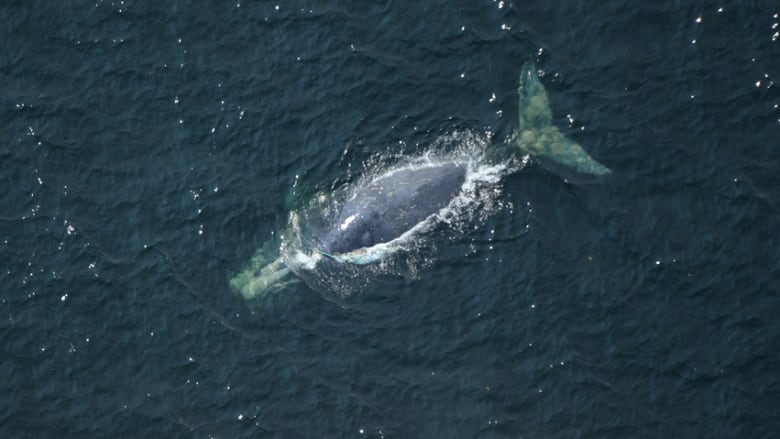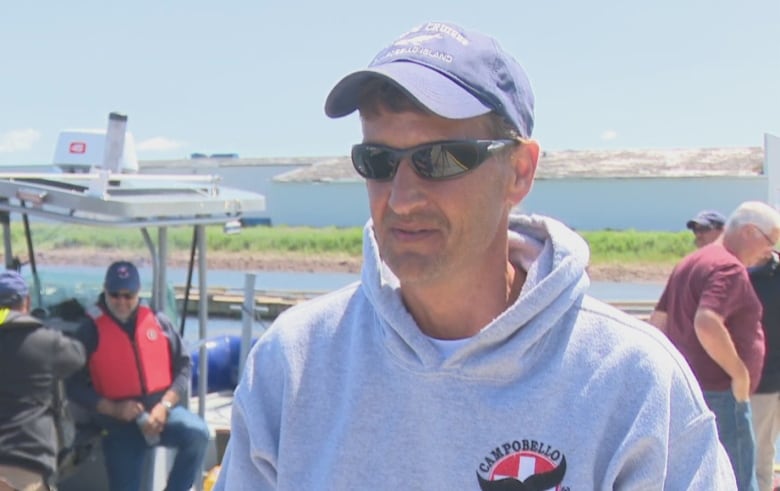Entangled North Atlantic right whale spotted in Gulf of St. Lawrence
Adult male Dropcloth was observed east of Miscou Island, N.B., Saturday, with other endangered right whales

An endangeredNorth Atlantic right whale has beenspotted entangled in fishing gear in the Gulf of St. Lawrence, east of Miscou Island, N.B., says Fisheries and Oceans Canada.
The whale, whichwas spotted Saturday by a DFO science team during a routine flight, has been confirmed as NARW No. 1271, also known as Dropcloth, an adult male of unknown age, according to a news release issued Tuesday.
Dropcloth, first documented in 1978, has been entangled at least four previous times, said Amy Knowlton, a senior scientist at the New England Aquarium."Unfortunately it's all too frequent an event."
The current entanglement appears to be one line through the whale's mouth, which may be affecting his ability to feed, said Mackie Greene,director of whale rescue for the Canadian Whale Institute.
"Although it's not a real complicated entanglement yeah,I think it's definitely impacting the whale's health," he said, noting the whale, named for his numerous spots,is swimming slowly and is grey instead of the usual shiny black.
The whale "isn't in great shape," saidBrett Gilchrist, director of national programs for Fisheries and Oceans Canada. "So we're, of course, actively seeking to disentangle that whale."
Conservation groups believe there are between 350 and 360 North Atlantic right whales left in the world,including fewer than 70 reproductively active females.
Fisheries and Oceans Canada's marine mammal response program is monitoring the situation to determine response options with its partners ifthe whale is located again, and if weather and sea conditions allow a disentanglement attempt.
The condition of the whale is a consideration in the timing of a rescue, said GIlchrist,but the safety of responders is also key."And weather plays a huge factor in that," he said.
A rescue team is on standby on Campobello Island, saidGreene, but he believes it will be at least Friday before the weather allows any attempts.
The wind has been blowing around 15 to 20 knots all week, "which is just too much," he said. "We're dealing with 20-foot poles, you know, with a sharp knife on the end, in a 20-foot boat. So we've got to have pretty good weather to, you know, to be able to be successful for a disentanglement."

The disentanglement itselfdoesn't look like it will be overly complicated, according to Greene.
"Ifwe can get in, make just one cut, you know,on either side of the mouth of the whale, we should be able to pull that [rope] right out."
Having said that, trying to sneak up on a whale and get near its mouthis no easy feat. "Anytime you get near them, they dive to try to get clear of ya. So it's really, really tough," he said.
"But like I say, I thinkit is doable."
The first challengewill be finding the whale again, said Greene, given the vastness of the ocean and the fact whales can travel75 to 100 nautical miles per day, even while entangled.
Crews recently spent two weeks trying to locate a young North Atlantic right whale, also spotted entangled in the Gulf of St. Lawrence, east of Miscou Island, in June, he said.
"The calf of [whale No.] 1812 was tagged off Shippigan, and went to P.E.I., and then the Gasp, and you know, it was almost to Anticosti once, and then up in the estuary of the St. Lawrence River, and you know, we finally caught up, untangled ifoff of Rimouski. So it really could be anywhere. It's a huge area.

Although whales can surviveentangled for a long time,the sooner Dropcloth can be located, the better, said Greene.
MoreDFO science survey planes will be out trying to spot the whale again, he said, and another research crew from Shippigan is scheduled to be searching the area for whales, starting Aug. 2.
"So hopefully this whale will be spotted again and we can get a chance to get out, you know, over the weekend or definitely by the first of the week."
4th entanglement so far this season
Officials don't yet knowthe type of gear involved or where it came from. These aretypically only confirmed after investigation and, when possible, when gear is removed from a whale.
But Knowlton said Dropcloth was gear-free when he was last spottedin Aprilby the Center for Coastal Studies in Massachusetts.
Four North Atlantic right whale entanglements have been documented in Canada so far this spring and summer, as well as a partial carcass, according to Fisheries and Oceans Canada.
"It just shows that despite the work that's underway in Canada and the U.S.," to reduce the risk of entanglements, it's not enough, said Knowlton.

Her group is urging both governments to shift toropeless, or on-demand gear, for all fisheries, where rope that typically goes to the surface is held instead on the sea floor until a fish harvester is on site to collect their gear and sends an acoustic signal to release it to the surface.
In the shorter term, the group wants to see governments implement the use of ropes that break more easily, which would enable entangled whales to break free.
Both measures have been trialled and are known to be effective tools in mitigating the risk of entanglement,Knowlton said.
Quick action neededto prevent extinction
"If we want to avoid the extinction of the species,really both governments have to step up their game," she said.
Oceana, aninternational advocacy group dedicatedto ocean conservation, is also calling on Fisheries and Oceans Canada to require ropeless gear in high-risk areas for North Atlantic right whale entanglements by 2025.
"The news of another whale entangled in fishing gear is heartbreaking,"Kim Elmslie, campaign director for Oceana Canada, said in a statement. "This crisis must be stopped."
Even minor entanglements can harm a right whale, leading to devastating injuries and death, she said. "The governments mustdo everything possible to immediately protect this critically endangered population, or Canada risks watching a whale species go extinct in our lifetime."
Whalesafe Gear Strategy pending
DFO believes its fishing closure protocols when North Atlantic right whales are spottedplay an important role in protecting the whales, said Gilchrist, noting mortality rates have dropped, compared to 2019.
When a whale is detected in the Gulf of Saint Lawrence, for example, the area is closed, along withupwards of 2,100 square kilometres around it, for 15 days. If a whale is detected in that area again, the closurebecomesseason-long, as was the case for the location where Dropcloth was spotted.
We do need to do more and we recognize that.- Brett Gilchrist, director of national programs, Fisheries and Oceans Canada
"But the reality is we do need to do more and we recognize that," he said. "That's why we launched the Whalesafe Gear [Strategy] in draft form earlier this late spring, early summer of this year."
It looks at variousfisheries across Canada todetermine what the risk level is for a potential "co-occurrence" with whale species, particularly endangered oneslike right whales, and determines if specific gear modifications may be needed, Gilchrist said.
DFO is currently seeking input from Indigenous and non-Indigenous harvesters, whale experts and other stakeholders on the strategy, "which will set the path forward for Canada and Canadian fisheries," he said.
Thegoal is to incorporate that feedback and have a final strategy launched in early 2025.
Knowlton remains "optimistic that we can turn the situation around for right whales if we all collaborate closely and help industries that operate out there, support them to, you know, change the way they operate their business."
With files from Rachel Cave













_(720p).jpg)


 OFFICIAL HD MUSIC VIDEO.jpg)
.jpg)



























































































